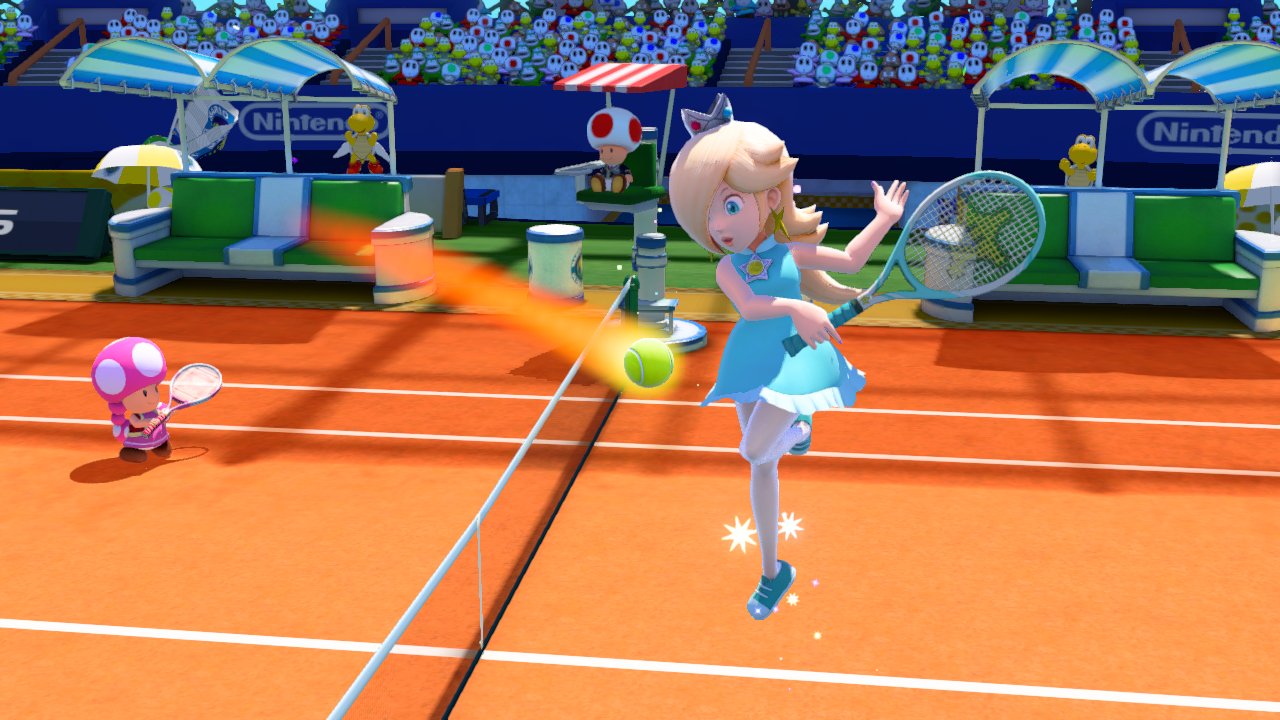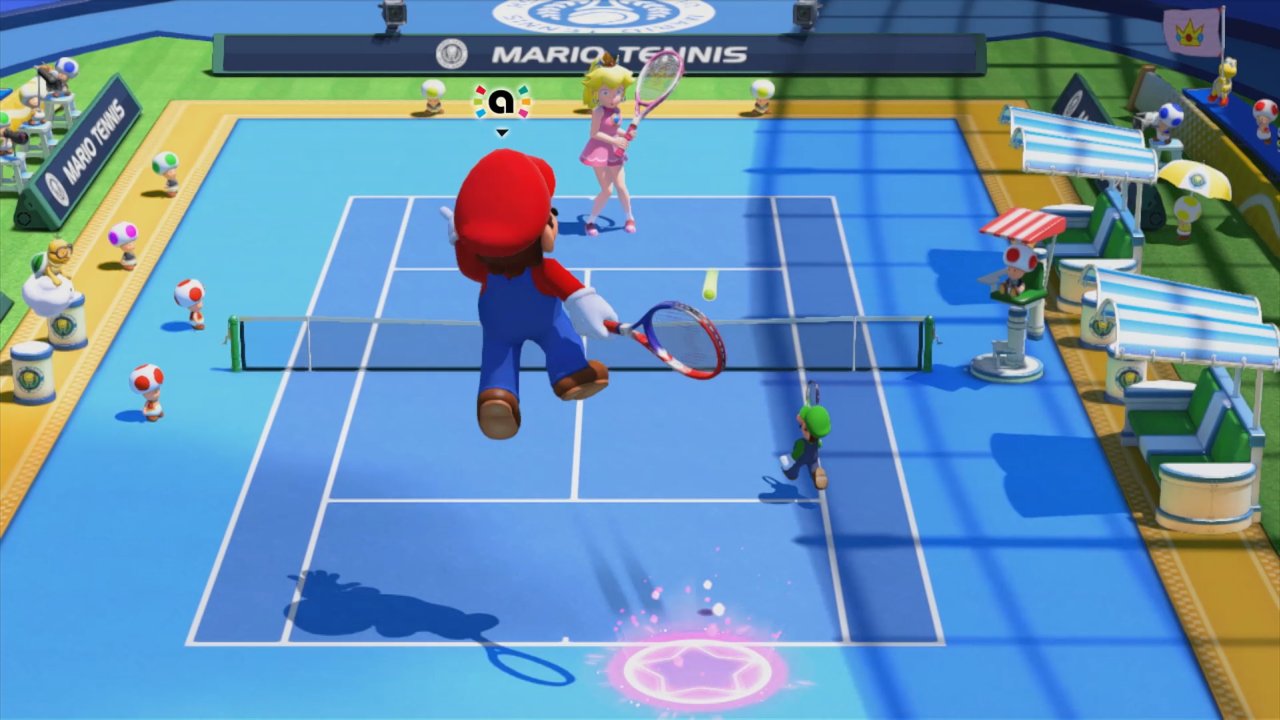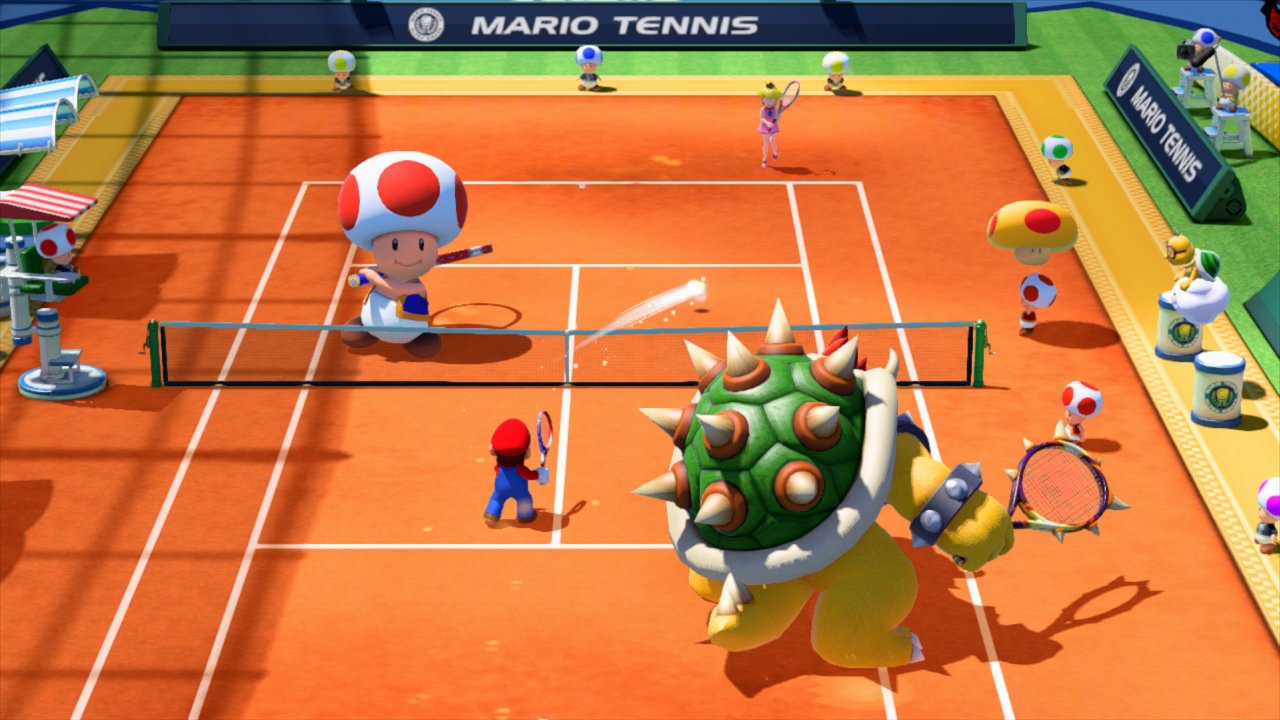Mario Tennis: Ultra Smash Review
Time and time again, gamers have been reminded that better graphics don’t necessarily make for a better game, despite the constant push for greater horsepower and aesthetics, sometimes even at the very expense of the gameplay itself. Few developers have proven this point more strongly and more consistently than Nintendo. Ironically, it is this same company that has, in a rare deviation from their normal practice, provided an example of this argument from the wrong side.

Enter Mario Tennis: Ultra Smash for the Wii U, the latest foray into the world of Nintendo sports titles starring the iconic multi-talented plumber and friends. This game just lacks so much depth and feels so dull and uninspired, that I find myself wondering why on earth it was even made. It merely feels like a title that was rushed out there in a desperate attempt to fill the gap of a lacking Wii U lineup, buying a bit of time for Nintendo to regroup and start fresh with its next home console. Perhaps Nintendo still held out some hope for recapturing some of the former Wii audience, or even some of that N64 crowd, that appreciated simple and to-the-point arcade style gameplay. But whereas many of those multiplayer titles were rich in both content and overall enjoyment, the only real thing of value I felt I gained from this unnecessary sequel is that it has reaffirmed my long-held beliefs of gameplay mechanics, content, and fun reigning supreme over graphical horsepower. This is a gaming philosophy that the champions of this creed, Nintendo, seemed to have disregarded in this game.
Though I was able to milk a little bit of enjoyment out of Ultra Smash here and there, especially with the split screen and online multiplayer, I had to search hard to find it, and it didn’t generally last long. Even during the game’s brighter moments, I merely found myself yearning for the good ol’ days of Mario Tennis on N64, with its solid mechanics and simplicity coupled with subtle elements of depth, or even its less iconic Gamecube successor, which was absolutely brimming with features, unlockables, and unique game modes. Ultra Smash brings neither the simplistic charm that its N64 predecessor had already perfected, nor does it hold a candle to Gamecube’s Power Tennis when it comes to the quality or quantity of its content. In most aspects the game feels like a regression from these multiplayer gems, which is disappointing when you consider the fact that those titles are several years older than their HD counterpart for Wii U. In fact, the only elements in which Ultra Smash truly excels are its aesthetics, which are admittedly quite pretty (particularly the ice court with its impressive reflections and glistening textures), along with welcome inclusion of an online mode, which does manage to provide some much-needed replay value.
The game’s features are about as bare-bones as Dry Bowser, yet not nearly as epic as he is. There is surprisingly no motion support to be had here, which is just one in a long laundry list of squandered opportunities in this game. And while the gamepad support is more than sufficient, the controller’s screen offers little in the way off additional features, and the Wii remote controls merely makes an already lackluster game feel even worse with its stiff and awkward control, courtesy of the d-pad. And although the game’s fun certainly ramps up when adding another player to the fold, at least one person will end up getting stuck with the Wii remote controls, which will likely diminish their enjoyment anyway. This NES style of controls simply does not work well with a relatively fast-paced 3D game such as this. Luckily this crisis can be averted if you happen to own a pro controller, which the game thankfully does support as well.

Rather than relying on a motion control gimmick however, the game’s theme revolves around a rather dull and pointless gameplay gimmick – mushrooms that make your character larger. This is really the only new gameplay element brought to the table, which is disappointing since it doesn’t really offer much except frustration and unbalanced matchups. The name of the game for these “Mega Battles” essentially boils down to – hope to be the first to scramble to a mushroom power up that Toad throws at you at seemingly random times, and overpower your opponent to an overwhelming advantage that is difficult to overcome. Of course, the opposing player can answer by snagging a mushroom of their own (which usually occurs before the first player has shrunken back to normal) which means you’ve now essentially gone back to equal stakes, making the mushroom relatively pointless in this frequently occurring scenario.
On the flip side, when you do have that small window in which only one player is mega-sized, there is a clear advantage granted, which is further enhanced when coupled with the absurdly over-powered “Ultra Smash.” In this scenario, unless the opposing player happens to be in the perfect location while frantically mashing buttons, it’s usually an instant point for the juiced-up player. All lack of balance aside, it can be somewhat satisfying at first to launch some furious spikes and Ultra Smashes as your mega-sized character while knocking your poor smaller and more vulnerable opponent backward, as well as covering a comically large portion of the court with your increased range, though the novelty wears off rather quickly.
The other core gameplay mechanic Ultra Smash revolves around is borrowed from the previous Mario Tennis entry on 3DS, known as “Chance Shots.” These essentially act as randomly-generated powerups, displayed by circular platforms that a player must rush towards, where they are then prompted to press one or two buttons from a series of recurring prompts. You are then granted an enhanced or otherwise altered behavior for your ball each time you land one of these sequences. This feature succeeds in some ways in terms of adding a little flair and color to the game, but it simultaneously shifts the focus away from tennis, and replaces it with a quirky mini-game vibe at times that lacks any real depth.

These prompts tend to feel out of place and often change the game dynamics more than they probably should. As these seem to be thrown more at the player the more they are successfully executed, this inevitably leads to players spamming their way to victory by riding out and stringing together these powerups. This generally keeps the opponent on their heels and, like the Mega Mushroom, shifts things towards an unbalanced match, and often one that is difficult to come back from. This feature also feels a bit flawed in its execution, as the platforms are frequently placed well out of range of the player, making it difficult to react in time to scramble towards and land those awkward button combos during those particularly heated moments. These gimmicks aside, we are essentially left with yet another Mario Tennis game with HD graphics and a stripped-down online mode.
Gone is any sort of fleshed-out tournament or campaign mode, replaced with the straight-forward and tedious “Knockout Challenge.” What you get is essentially a glorified sequence of matches against different CPU characters that get steadily more challenging as the game progresses. Aside from this slowly and subtly increase in difficulty however, there’s no real feeling of progression, and it doesn’t take long before this mode feels monotonous. The seemingly random variation of different courts help to keep things at least a tad fresh, but most are just as dull as the game itself. The aforementioned ice court does look pretty, and there are some rare moments of excitement to be had with the chaotic Morph Court and Rebound Court, which actually affect the gameplay more than simply controlling the speed and bounce of the ball. Yet, the palette of stages are generally lacking in terms of distinct or memorable characteristics. Like the characters themselves, most of the courts are just sort of “there,” and don’t particularly stand out from one another.
In keeping with the game’s “Mega” theme, I was pleasantly surprised to see some semblance of a “boss” in the form of a giant Bowser, which awaits you after a long and tedious run of facing each character throughout the Knockout Challenge. This encounter offers at least a dash of a new experience. However, once you’ve gotten past the neat, yet brief Magikoopa cinematic that sets the stage for this showdown, you are essentially just playing yet another game of tennis, the only difference being that you are now facing off with a gigantic and more challenging CPU. Despite how little the single player Knockout Challenge mode offers, you will be bummed to learn that this is actually the bulk of the gameplay, at least when it comes to the single player modes.

The secondary single player option, “Mega Ball Challenge,” comes off as little more than a drawn-out practice mode, as your only goal is to face off for as long as you can against a CPU opponent. The only differentiating feature is the behavior of the ball, which starts out large and floaty, and gets progressively smaller and speedier (and thus trickier to stay with) the longer you carry on without missing a return from your computer opponent. This has very little staying power, and I quickly found myself bored with it, even when facing off against the higher difficulty AI, which actually has the ability to keep the streak going without flubbing. Not even the lure of racking up coins (of which you are only granted few anyway) could entice me back to this one.
Speaking of coins, these are basically your universal Ultra Smash currency, which allow you to purchase a modest selection of twenty-five total unlockables. These include everything from additional courses, extra players, increased difficulty settings, and “star” versions of each player, which supposedly provide you with a powered-up version of each character, though I didn’t notice much of a difference upon testing them out. These unlockables bring a touch more to the experience, and provide at least some sort of incentive to play on. However, once you’ve snagged them all, most of that incentive quickly evaporates, as your coins become virtually useless. You also have the option to unlock most of these goodies via in-game tasks, though I found this to be mostly pointless, considering how quickly and easily you are able to gather coins. A few good win streaks during the Knockout Challenge and some quality online matches, and suddenly you find yourself able to rattle off a large chunk of Ultra Smash’s unlockables in one fell swoop.
If the quirky aforementioned features aren’t your cup of tea, you are granted some nostalgic simplicity with the Classic Tennis mode, which includes Standard and Simple modes. The former tosses the mushrooms aside, making for a more balanced match, and the latter provides you with an absolute stripped down Mario Tennis experience, ditching all the distracting and largely tacked-on gimmicks. Like in the Mega Battle, you can choose to play singles or doubles, complete with a varying number of sets, matches, or a single tiebreaker game, in which the first person to hit seven points wins. There isn’t much to say about this feature, yet considering all of the bizarre and somewhat flawed additions found elsewhere, this is not necessarily a bad thing.

The online mode is admittedly a great addition, and one that almost single-handedly acts as a sort of saving grace for this otherwise lacking sequel, if there was one to be had. Not surprisingly, there isn’t much to it, though there doesn’t really need to be, as the mere ability to square-off randomly with opponents online is a refreshing oasis of fun amongst a desert of dullness. I did run into some lag hiccups and the occasional disconnect, but overall my online experience was surprisingly pretty smooth.
Like the other modes, Ultra Smash offers the choice between singles or doubles when playing online. On top of this, you may chose to engage in a more serious battle, which provides you with a rank similar to the recent Mario Kart entries, or can decide to play it more casually with the “Play for Fun” mode, which generally pits you against some simpler competition. You can chose whether or not you wish to have mushrooms or Chance Shots in the mix as well. Nintendo thankfully included the convenient option to search for any type of game, with any number or sets. This was a wise move, as I discovered that getting specific in your matchmaking preferences led to some long waiting times. Not surprising, since there are likely few out there to even match up with in the first place. This was especially apparent when attempting to play doubles online. We’re not talking about Call of Duty here when it comes to the size of the online community, after all.
One side note is that there is amiibo support throughout the game, which helps to add a bit of depth here and there. At the same time, there could have been more to it than Ultra Smash offers. Scanning an amiibo provides you with a glorified AI comrade, similar to the latest Smash Brothers entry on Wii U. This makes both the Knockout Challenge, as well as the online doubles mode, a tad more interesting as you are able to team up with your AI character. Unfortunately, the usefulness of your virtual partner leaves much to be desired, and actually seems to hinder more than assist. You will likely have some frustrating moments where your amiibo doesn’t get to the ball, or ends up whacking you in the back of the head when they do hit the ball. This becomes less of an issue throughout the course of the game, as you are able to train your amiibo through earned stat points. Oddly though, the points are randomly spread across different abilities, and the only real control you have over this is the mostly pointless option to spend coins to reset your amiibo’s learning progress. I suppose this feature is worth giving a go if you happen to already own a supported amiibo, but it certainly isn’t worth shelling out for one just to use for this game.

At the end of the day, Mario Tennis: Ultra Smash is a mediocre sequel at best, and one that just doesn’t have much of a point to it. It’s hard to even recommend at a discount price, unless you are planning on playing with a friend, or heavily utilizing the somewhat enjoyable online play. Indeed, the online functionality, while pretty basic, provided me with the majority of the fun to be had in this game, and is essentially the sole element that makes it worth even giving this a second thought. The game just feels rushed, thanks largely to its lack of features and shallow gameplay that somehow manages to be too simple, and at the same time, provides moments of confusion as a result of its lack of in-game explanations. Unless HD graphics and online play are that big of a deal breaker for you, you’re better off simply opting for the original classic on the N64, which can still be enjoyed on the Wii U via the virtual console, and at a much cheaper price to boot.
